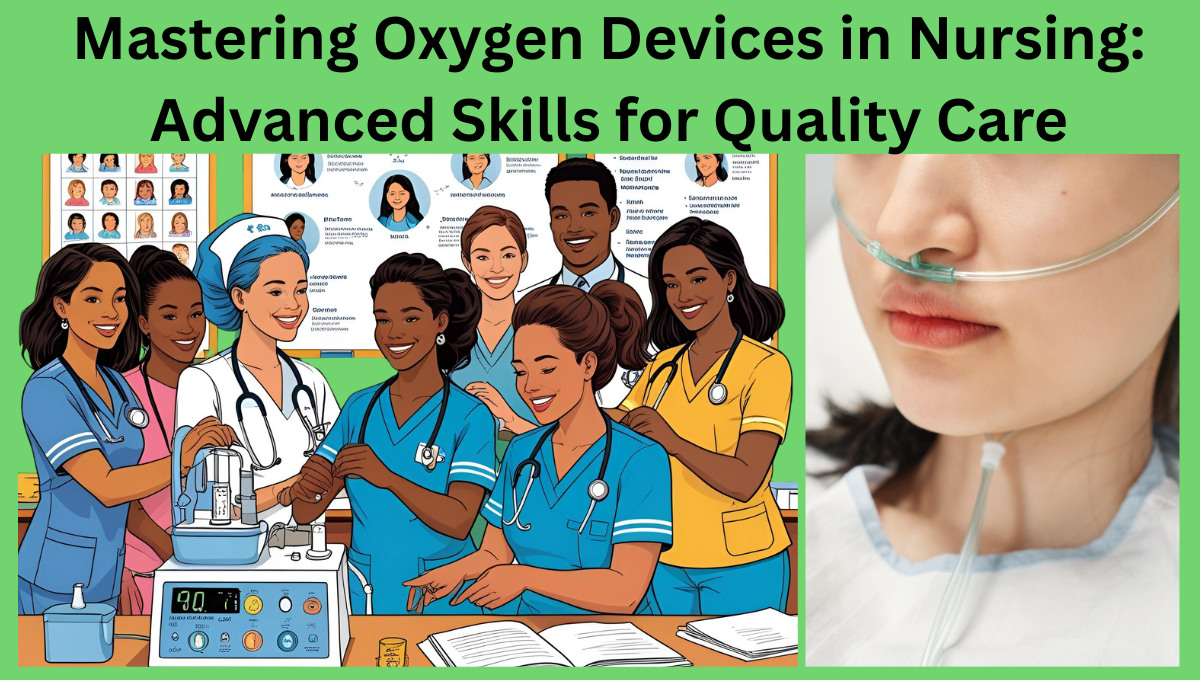Mastering Oxygen Devices in Nursing: Advanced Skills for Quality Care
Introduction
Oxygen therapy is a crucial component of contemporary patient management. Nurses are essential in giving, managing, and monitoring oxygen therapy across emergency rooms, intensive care units, and home care environments. It is not only about donning a mask; it involves comprehending when, why, and how to utilize each oxygen apparatus for maximal efficacy.
This book will delineate the various types of oxygen therapy devices, their clinical applications, the advanced nursing competencies required, and optimal practices to guarantee safety and quality care.
Comprehending Oxygen Therapy
Oxygen therapy involves the provision of supplemental oxygen to individuals experiencing hypoxemia (reduced blood oxygen levels). It facilitates tissue perfusion and oxygen transport to essential organs. Prevalent illnesses for oxygen therapy encompass
Chronic Obstructive Pulmonary Disease (COPD)
Asthma
Pneumonia
COVID-19
Cardiac insufficiency
Acute Respiratory Distress Syndrome (ARDS)
Aims of Oxygen Therapy
Ensure sufficient oxygen saturation (typically exceeding 92%)
Mitigate hypoxia-associated complications
Facilitate respiration in acute and chronic conditions
Categories of Oxygen Administration Devices
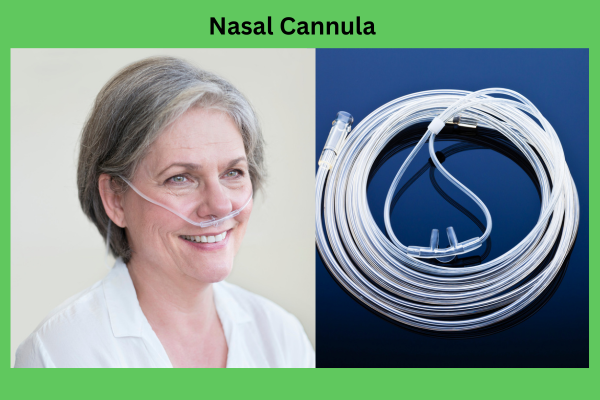
Nasal Cannula
The nasal cannula is the most often utilized apparatus. It administers low-flow oxygen via two flexible prongs inserted into the nose.
Flow rate: 1 to 6 liters per minute
FiO₂: 24–44 percent
Indicated for: Mild hypoxia in ambulatory patients
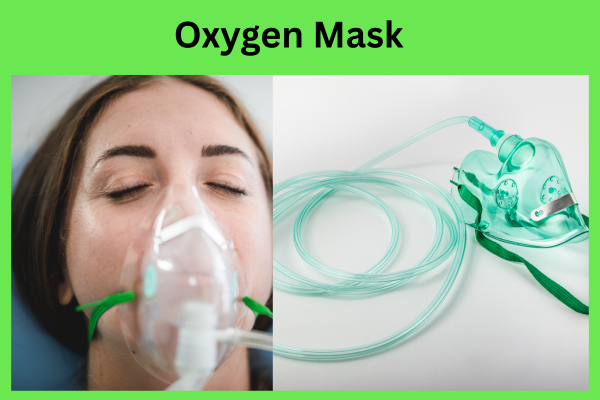
Basic Facial Mask
This apparatus provides moderate oxygen levels and encompasses both the mouth and nose.
Flow rate: 6 to 10 liters per minute
Fraction of Inspired Oxygen (FiO₂): 40–60%
Indicated for: Temporary oxygen assistance, postoperative individuals Venturi Mask
A Venturi mask administers exact oxygen amounts. It is optimal for COPD patients necessitating precise FiO₂ levels. FiO₂: 24% to 60% Principal characteristic: Color-coded adaptors according to oxygen flow
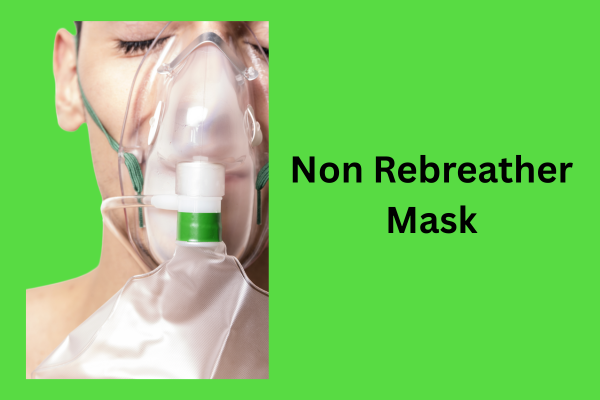
Non-Rebreather Mask (NRBM)
This provides elevated levels of oxygen through a reservoir bag and unidirectional valves.
Flow rate: 10 to 15 liters per minute
Fraction of Inspired Oxygen (FiO₂): Up to 100% Indicated for: Emergency scenarios, trauma, shock
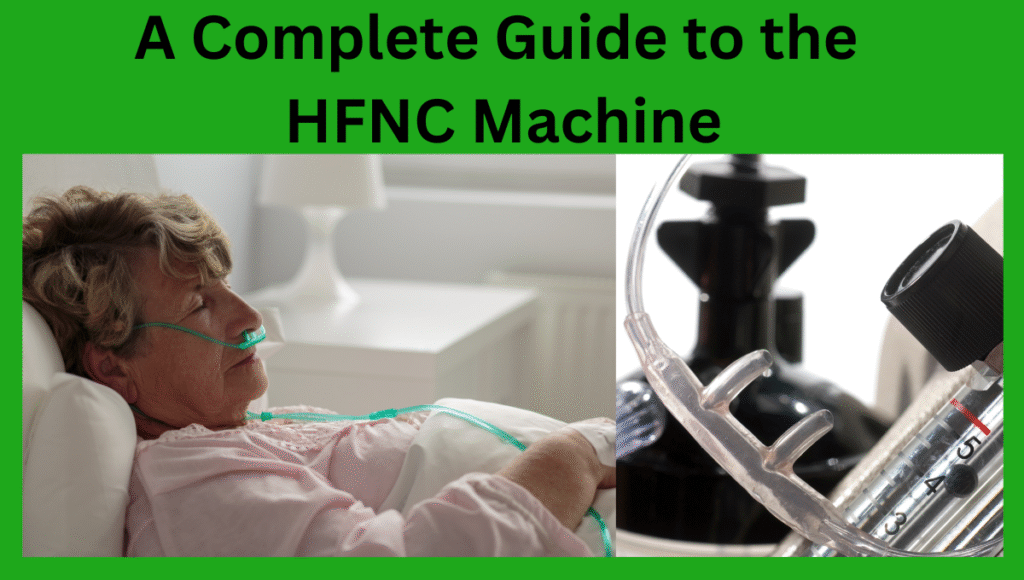
High-Flow Nasal Cannula (HFNC)
This advanced device provides heated and humidified oxygen at elevated flow rates.
Flow rate: Maximum of 60 L/min Indicated for: Severe hypoxemia, pediatric patients, COVID-19
Continuous Positive Airway Pressure (CPAP) and Bilevel Positive Airway Pressure (BiPAP)
These are non-invasive positive pressure breathing apparatuses employed in obstructive sleep apnea. Pulmonary edema, chronic obstructive pulmonary disease with carbon dioxide retention Selecting the Appropriate Device:
The choice of the oxygen delivery apparatus is contingent upon: Patient’s respiratory condition Necessary Fraction of Inspired Oxygen Level of consciousness and collaboration Tolerance and ease Requirements for mobility Nurses must employ clinical judgment to reconcile efficacy with patient comfort. An elderly patient may exhibit greater tolerance for a nasal cannula compared to a face mask. Proficient Nursing Competencies in Oxygen Therapy
Evaluation and Surveillance
Assess vital signs, oxygen saturation (SpO₂), respiration rate, and cognitive function. Utilize pulse oximetry to inform treatment. Monitor for indicators of respiratory distress: cyanosis, disorientation, and elevated respiratory effort.
Modifying Oxygen Flow
Administer oxygen according to the physician’s directives and the patient’s needs. Exercise caution with COPD patients to prevent the suppression of their respiratory drive.
Mitigating Complications
Utilize humidifiers to avert dryness in the nasal passages and throat. Examine for dermal deterioration surrounding the nose and ears. Be cognizant of the hazards of oxygen poisoning when utilizing elevated amounts for extended durations.

Patient Education
Provide guidance on the correct utilization of home oxygen apparatus.
Emphasize safety precautions (e.g., refrain from smoking in the vicinity of oxygen). Maintenance of Oxygen Devices and Infection Control
Nurses must verify that all oxygen delivery apparatus is
Maintained routinely Modified in accordance with procedure (e.g., nasal cannula every 5–7 days) Not disseminated among patients Accurately labeled to prevent cross-contamination Masks and tubing must be examined for moisture accumulation, fissures, or contamination. Oxygen Safety Protocols for Nursing Professionals
Oxygen is combustible. Essential precautions encompass
Maintaining a safe distance between oxygen sources and blazing flames Properly securing oxygen cylinders Refrain from utilizing petroleum-derived items in proximity to oxygen.
Ensuring the visibility of “No Smoking” signage Instructing both personnel and patients on these processes is essential. Documentation and Reporting Nurses are required to document:
Type of oxygen apparatus utilized Flow rate and fractional inspired oxygen concentration (FiO₂) Duration and frequency Response from the patient Any negative consequences or modifications in treatment: Immediately notify of any deterioration in hypoxia, emergence of new symptoms, or heightened oxygen requirements.
Case Scenarios
Scenario One: Post-Operative Patient
A patient convalescing from abdominal surgery exhibits minor hypoxia.
Nasal cannula
Nurse’s Action: Administer oxygen at 2 L/min and assess SpO₂ levels.
Scenario 2: Exacerbation of Chronic Obstructive Pulmonary Disease
Senior male with chronic obstructive pulmonary disease and elevated carbon dioxide levels.
Device: Venturi mask delivering 28% FiO₂
Nurse’s Action: Administer low-concentration oxygen and meticulously check arterial blood gases and level of consciousness. Scenario 3: COVID-19 with Respiratory Distress Patient exhibiting SpO₂ levels below 85% despite the use of a nasal cannula.
Device: High-flow nasal cannula
Nurse’s Action: Elevate to 40–60 L/min with warm, humidified oxygen; commence referral for respiratory therapy.
Guidelines for Nurses in Oxygen Delivery
Consistently verify connections and tubing. Utilize extension tubing judiciously—potential danger of diminished oxygen flow. Engage with respiratory therapists for sophisticated configurations. Verify that the oxygen source is fully charged and securely fastened during shipment. For unconscious patients, affix the mask to avert displacement.
Professional Development Opportunities for Nurses
To cultivate self-assurance and proficiency, participate in simulation-oriented workshops.
Fulfill online certification programs (e.g., AHA ACLS, AACN Oxygen Therapy courses). Observational respiratory therapists Engage in clinical skill enhancement exercises at your medical facility. These trainings ensure you remain informed on contemporary devices such as HFNC, portable oxygen concentrators, and hybrid masks.
Final Assessment
Oxygen therapy encompasses not only equipment but also critical analysis, prompt action, patient advocacy, and proficient hands-on care. As a nurse, proficiency in the utilization of oxygen devices can profoundly influence patient outcomes, particularly in emergency or critical care situations. Your participation is vital, whether you are modifying flow rates, selecting the appropriate device, or instructing a patient on the safe use of home oxygen. With sophisticated expertise and appropriate training, you are not only administering oxygen; you are imparting life.
FAQs
1. How can nurses evaluate the efficacy of oxygen therapy?
By assessing enhancements in SpO₂, respiratory patterns, cognitive acuity, and general comfort.
2. What are the indicators of oxygen toxicity?
Alterations in vision, cephalalgia, anxiety, weariness, and, in extreme instances, seizures or pulmonary damage.
3. Is it permissible for a patient to consume food or beverages while wearing an oxygen mask?
Exclusively utilizing nasal cannulas. Masks should be temporarily removed during meals if it is safe to do so.
4. What is the recommended frequency for replacing masks and tubing?
Nasal cannulas: every 5 to 7 days; face masks: every 24 to 48 hours or when clearly contaminated.
5. What actions should a nurse take if oxygen saturation continues to decline?
Reevaluate the airway, inspect the equipment, elevate the level of care, and promptly inform the physician.

